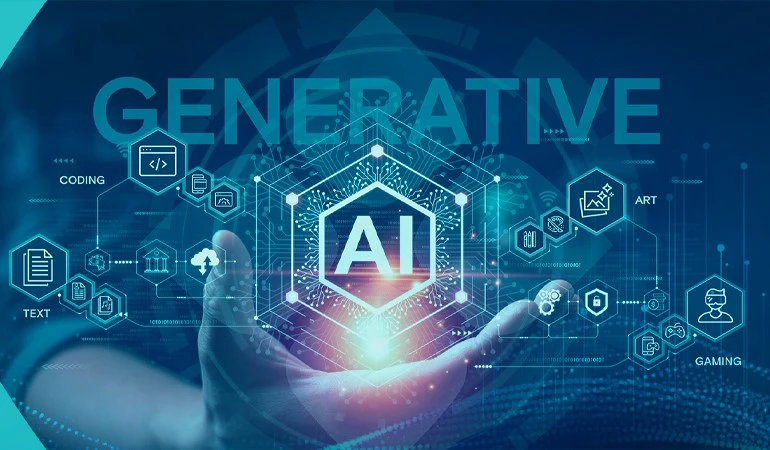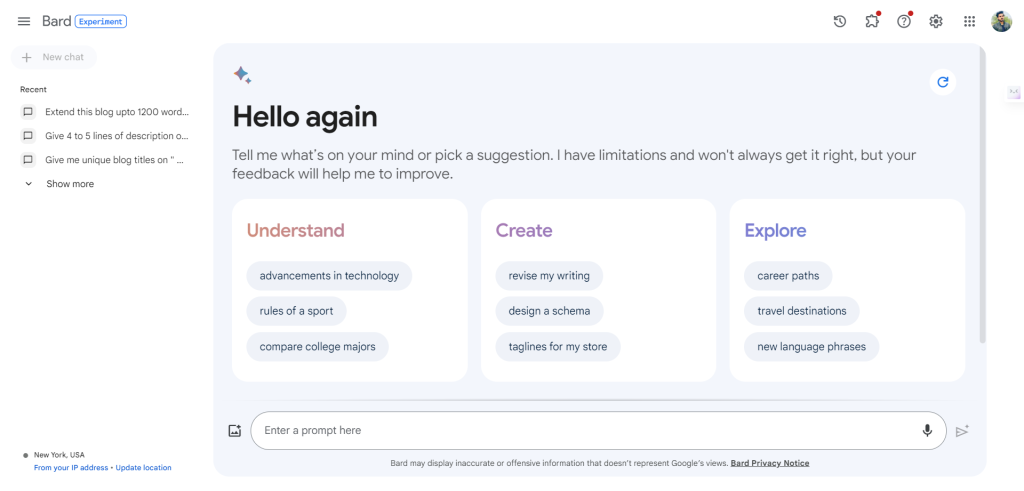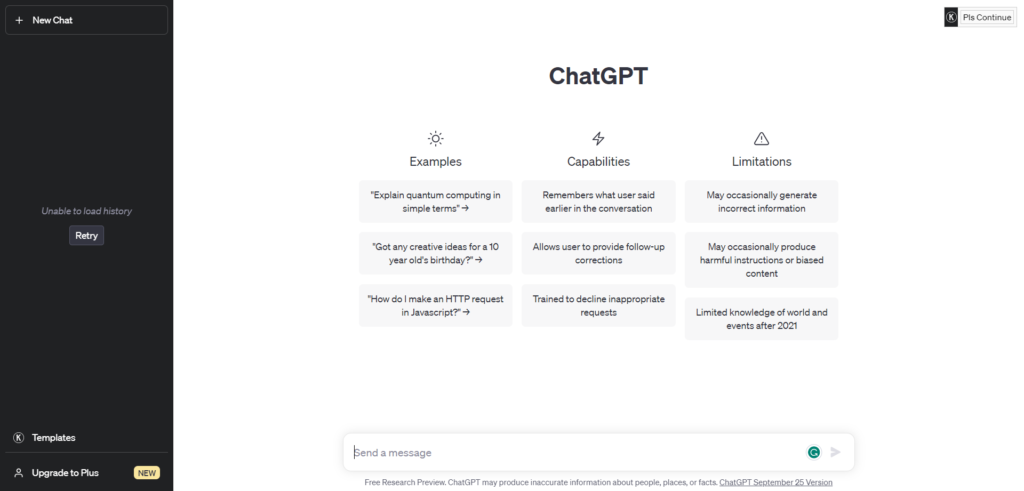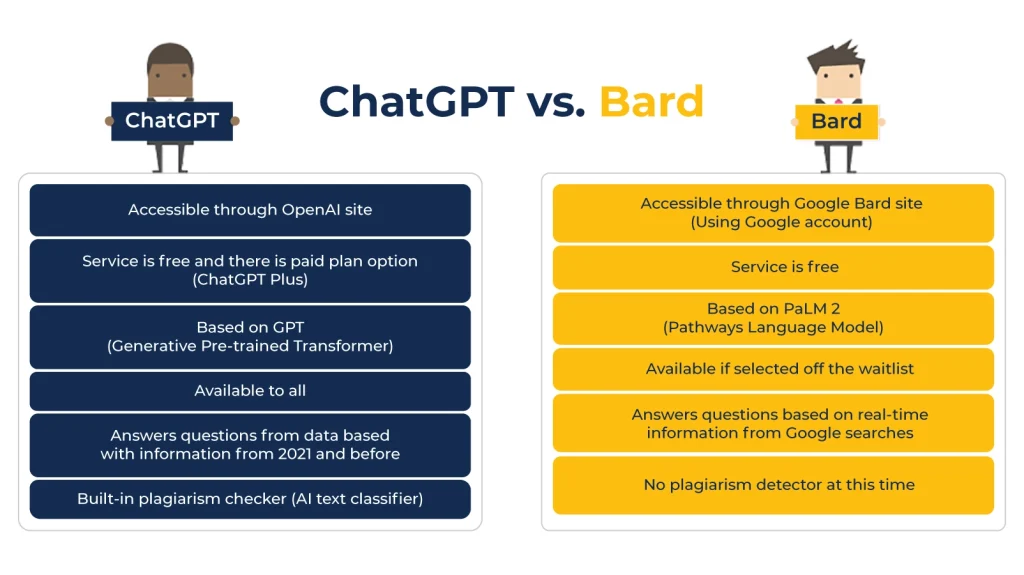Generative AI has become a buzzword ever since OpenAI launched ChatGPT in November 2022. Although many looked to Google for advances in artificial intelligence (AI), it was OpenAI’s ChatGPT that stole the show in the realm of generative AI by being the first-of-its-kind tool. In March 2023, Google launched its own generative AI chatbot Bard to counter the Microsoft-backed ChatGPT. The battle between the tech giants or bard AI vs ChatGPT is now in full swing.
While both tools fall under generative AI, a branch of artificial intelligence, there are differences between the two. This article gives a comprehensive overview of the two tools. But first, let’s discuss what generative AI is followed by a description of each tool, Bard and ChatGPT.
What is Generative AI?
Generative AI is a field of artificial intelligence that generates new content based on user queries. This content can be in the form of text, video, image, audio, and 3D models. Generative AI uses neural networks to analyze and identify patterns in existing data to create original content.

From marketers and software developers to product designers and students, people from all walks of life are using top AI tools like ChatGPT and Google Bard for various purposes. These amazing AI tools allow them to access unique content in no time. You can generate a poem, an article, a website code, and a lot more. In other words, they generate human-like responses to user input and queries.
However, these generative AI tools based on large language models have certain limitations too. For instance, ChatGPT clearly states that the chatbot can give factually incorrect, biased, and outdated information. Bard also concedes that it may not always be right and can even provide offensive output.
Notwithstanding these limitations, ChatGPT gained a whopping one million users within five days of its launch – the fastest-ever score across all digital platforms created so far.
Before we compare Bard and ChatGPT, let’s explain each platform briefly.
What is Bard?
Originally based on LaMDA, a family of conversational large language models developed by Google, Bard is a generative AI chatbot that has now been updated to PaLM2. PaLM2 is an advanced language model that offers exceptional coding, reasoning, and multilingual capabilities. Google launched Bard in 2023, just a few months after OpenAI launched ChatGPT.

Both ChatGPT and Bard have some similarities. They use natural language processing and transformers to interact with users. However, Bard has an edge over ChatGPT in that it offers the latest information to users – ChatGPT-3, on the other hand, is trained on a dataset that contains no information beyond September 2021. Bard also provides the sources from where it generates responses to prompts.
What is ChatGPT?
ChatGPT is OpenAI’s generative AI chatbot that performs almost the same functions as Bard. It was launched in November 2022 and has since gained immense popularity. It employs deep learning, NLP, and large language models to interact with users in real-time.

Moreover, ChatGPT is trained on a vast dataset from the internet with billions of parameters. OpenAI has really exciting plans for ChatGPT. The company is planning to enhance its capabilities so that it can better respond to changing user needs. It also wants to provide updates so that the tool can have better platform compatibility and improved features.
ChatGPT vs. Bard
ChatGPT – It is an AI language model developed by OpenAI and supported by a multiyear partnership with Microsoft. GPT stands for Generative Pre-trained Transformer, a state-of-the-art language model architecture that utilizes deep learning techniques, specifically a transformer-based neural network.
The model is trained on vast amounts of text data, such as books, articles, and websites, to learn patterns, grammar, and contextual relationships within the language. The chatbot currently uses GPT-3.5. However, the premium version, called ChatGPT Plus, uses the more advanced GPT-4 model. Bard is an advanced chatbot capable of creating more and better chunks of information. On the other hand, ChatGPT is good at generating content with only a single text prompt.
Bard – It is a large language model, also known as a conversational AI or chatbot, created by Google AI. Bard is trained on a massive dataset of text and code and is able to generate text, translate languages, write different kinds of creative content, and answer your questions in an informative way.
Bard is based on LaMDA (Language Model for Dialogue Applications), a neural network-based language model. It’s trained on a vast dataset – it is 137 billion parameters in size. According to Google, the language model uses deep learning and is currently under development. However, it excels at conversational AI.

Major Differences Between ChatGPT and Bard
Many people wonder which language model is a better generative AI chatbot. We have analyzed the two according to different benchmarks, including text processing and generation abilities, training dataset and underlying technology, internet access, ability to respond like humans, the accuracy of responses, interface and user-friendliness, and pricing.
The major difference between the two platforms is the data sources that can be utilized to train the LLMs which also power them. Bard is excellent for research purposes while ChatGPT excels at writing. The differences can be best evaluated based on conversational AI vs generative AI. Generative AI vs. Conversational AI is Bard vs. ChatGPT.
1. Text Processing & Generation
Text processing, summarization, generation, and translation are some of the major tasks modern AI chatbots like Bard and ChatGPT perform. Bard is more popular when it comes to conversational AI. However, if you talk about text summarization or generation, ChatGPT takes the prize.
It is an excellent tool for generating unique text like essays, poems, song lyrics, etc. Therefore, ChatGPT is a better tool when it comes to natural language processing techniques, as it can perform various textual-level roles.
2. Training Dataset & Underlying Technologies
Both chatbots employ neural networks called transformers; these networks perform sequential input processing. However their training datasets are not the same; in fact, there are significant differences.
OpenAI’s trainers scraped the web to create an extensive textual dataset using the data on the internet. To make it, they fed hundreds of thousands of books, documents, articles, etc.
On the other hand, the team at Google AI used Infiniset to train Bard. It is designed explicitly to enable conversational AI and human-like responses. This is why Bard is better at having robust conversations with its users, sounding much more natural than ChatGPT.
Bard is able to understand the intent behind a user’s questions and the nuance of context in a conversation, thanks to a hierarchical clustering of high-level concepts and topics. Its trainers designed it such that its responses are super-authentic and imitate human speech so precisely that it is difficult to tell them apart from those of a human.
3. Internet Access
Another key difference between the Bard and ChatGPT lies in internet access. The variance between the two AI-powered chatbots is that Bard can access internet data in real-time, while ChatGPT has internet data only until September 2021. This considerable difference gives Bard a clear advantage over ChatGPT since it means that the latter has no knowledge of the events after the cut-off date. Moreover, Bard also presents search results from the internet if you click the Google it button; ChatGPT has no such feature.
4. Human-like Responses
Generative AI chatbots are often judged against their ability to sound like humans. In this case, owing to Infiniset (a conversational dataset), Bard outperforms ChatGPT. It usually offers more human-like responses than ChatGPT and can imitate human speech more accurately than OpenAI’s brainchild ChatGPT.
Also, ChatGPT can include images in responses. In generative AI vs ChatGPT, the two are distinct concepts capable of producing human-like responses. However, ChatGPT vs. generative AI reveals that both focus on producing content in general.
5. Response Accuracy
Response accuracy and authenticity are vital factors in a chatbot’s success as they help build trust and credibility in the eyes of the user. Both ChatGPT and Bard fall short on this account. However, Bard is constantly learning new information through the internet, which also makes it more susceptible to peddling fake news as real.
ChatGPT also gives factually incorrect information at times. This makes the use of these AI-enabled chatbots risky. This is one of the reasons why many leading AI and tech industry thought leaders, including the billionaire Elon Musk, called for a pause in AI development.
6. Interface & User-friendliness
Judging an application’s interface can often be a subjective endeavor. While some people think Bard’s white background and clean interface make it better, others believe that ChatGPT’s darker background is more appealing. Bard allows users to edit questions while ChatGPT does not – you have to wait for the model to generate a response before asking another query. Both chatbots allow users to upvote or downvote a response.
7. Pricing
Both chatbots are currently freely available to all as they are in the experimentation stage. However, ChatGPT offers a premium version for roughly $20/month.
Sum Up
To sum it up, both chatbots are excellent tools. So, is ChatGPT better than Bard? No one can answer that definitely. In some fields like user-friendliness, human-like responses, and updated information, Bard seems to outperform ChatGPT. On the other hand, ChatGPT is a much better option for text processing, summarization, and generation. Bard is free as of now, but ChatGPT terminates the free account whenever it wants, asking users to switch to ChatGPT Plus. Your business requirements and goals can determine the tool that suits you best.
Xavor is a leading AI/ML solutions provider – contact us at [email protected] if you want to build AI/ML solutions for your business or want application integration through ChatGPT’s API.
FAQs
Q: Difference between chatbot Bard and ChatGPT:
Ans: Bard is Google’s conversational AI, while ChatGPT is developed by OpenAI. They both aim to generate human-like text, but their underlying models and capabilities may vary.
Q: Which is the better AI chatbot, Google Bard or ChatGPT?
Ans: The choice depends on your specific needs. Google Bard and ChatGPT have their strengths and weaknesses, so evaluate based on factors like accuracy, language quality, and compatibility with your tasks.
Q: Difference between generative AI and ChatGPT:
Ans: Generative AI is a broader category encompassing AI models like ChatGPT. ChatGPT is a specific implementation of generative AI designed for natural language understanding and generation.
Q: Is Bard AI more accurate than ChatGPT?
Ans: Accuracy can vary depending on the context and use case. Both Bard AI and ChatGPT aim for high accuracy, but the superiority may depend on specific scenarios and evaluation criteria.












